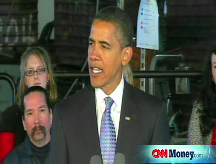Green stimulus: Show me the money
Critics say funding to create a 'smart' electric grid is not enough, and suggest that moves to thaw investments in renewable energy may not work.
NEW YORK (CNNMoney.com) -- The new Congress and President Obama were talking big when it came to the green factor in any stimulus plan.
Moving the economy away from fossil fuels and toward clean, renewable energy got lots of ink, as did the plan to rebuild the nation's aging power grid.
But as details of the stimulus plan emerge, some are saying the money promised falls far short of what it will take to deliver tomorrow's energy.
"I was surprised at how little there was for the grid," said Joel Kurtzman, a senior fellow at the Santa Monica, Calif.-based Milken Institute, a think tank. "It's not adequate."
Politicians have been saying they are going to create a so-called "smart grid" as part of the $825 billion stimulus plan.
They acknowledge that the stimulus is just seed money to get the smart grid going, and that the stimulus - in general - is supposed to focus on projects that are ready to go right now.
The smart grid basically involves digitizing and connecting the country's aging utility grid.
Experts say it will result in greater efficiency because appliances will be able to turn on and off when electricity is cheapest, consumers will have more information about how much electricity they are using, and when and where they are using it.
The smart grid is also essential if various forms of renewable energy like wind and solar are to be used.
But the smart grid isn't cheap. Estimates vary, but some say electric investments of all kinds - including grid, power plants, conservation and the like - will need to total $2 trillion over the next two decades.
Simply digitizing the grid and providing new meter readers could cost $400 or $500 billion.
Yet the House stimulus bill unveiled last week contained just $11 billion set aside for the electric grid in general - and only $4.5 billion specifically targeted to smart technologies.
"Four and a half billion doesn't sound like a lot of money in the context of smart grid," said George Given, head of global power research at the energy consultancy Wood Mackenzie. "There's a real opportunity to make a difference, but there needs to be a lot more hard science and finance worked out."
Although the $4.5 billion is more than what some supporters were calling for, Milken's Kurtzman said the stimulus bill - which is still in early form and will evolve over the next few weeks - should have included more incentives for the smart grid. In particular, he wanted more tax credits for investors who put money into the grid.
Representatives on the House Committee on Energy and Commerce, responsible for most of the energy and energy tax portions of the bill, could not be reached for comment.
But it's generally been argued that the stimulus bill is just the first salvo in the attempt to modernize the grid. More money will likely flow to the grid by the time the year is out, maybe in the form of an energy bill.
And most experts say the stimulus bill, paid for with borrowed money, should contain just the projects that are ready to go and can create jobs right now - not money for projects that may be a good idea but aren't labor intensive in the short term.
Another big part of the energy portion of a stimulus was supposed to keep money flowing into the renewable energy sector.
The financial crisis has brought investments in renewable energy to a standstill. Most alternative energy projects were previously financed by banks - which then took generous tax credits to help offset their profits.
But now that most banks are booking massive losses, there's little incentive to invest - since prior tax credits applied only to profits.
"The majority of all projects are going to come to grinding halt," said Lyndon Rive, chief executive of SolarCity, a developer of solar power projects. "People don't understand the impact this will have."
As lawmakers scrambled to write the House bill, the renewable industry pushed to make these tax credits refundable - meaning banks could apply them to past profits and get the money refunded from the government.
That wasn't included in the House bill, and it's not immediately clear why.
Instead, the industry got financing from the government in the form of loan guarantees and direct grants.
Analysts hold out high hope for these grants, although it's not yet clear how much they will total or how they will be run.
"Direct DOE grants may allow project developers to finance projects without complex tax equity structures," reported The Stanford Group, a policy research firm, in a research note Tuesday.
But Stanford acknowledged that too little is known about the grant program at this time to make a conclusive analysis of it.
"It is unclear if projects would compete for a limited number of funds or how the DOE application process would work or how long it would take," the note said. "At this point, we do not know if Senate Finance Chairman Max Baucus and Senate Energy and Natural Resources Committee Chairman Jeff Bingaman support such a program. We'll be watching closely how this program develops..."
SolarCity's Rive said the grants could do the trick, if they totaled at least $5 billion and were easy to obtain - a proposition he indicated wasn't likely.
"The historic experience of getting grants from the DOE has been like pulling teeth," he said.
Whatever lawmakers do to get the money flowing again, said Rive, they need to do it now.
"This can't be something that comes after stimulus," he said. "By then, it will be too late for the industry." ![]()



